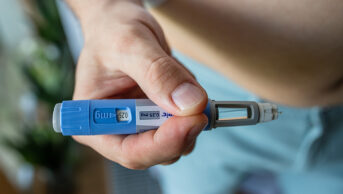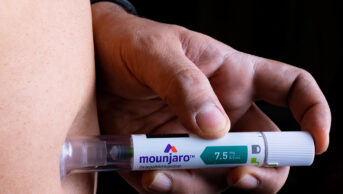
Pavla Zakova / Dreamstime.com
A daily injection of liraglutide can help obese or overweight patients with type 2 diabetes lose weight if they also follow a low calorie diet and do more exercise, according to research published in JAMA
[1]
on 18 August 2015.
Researchers found that 25.2% of patients lost more than 10% of their body weight when given 3.0mg liraglutide (marketed as Victoza and Saxenda by Novo Nordisk for type 2 diabetes and chronic weight management, respectively
) daily if they also cut down on food by 500 calories a day and completed at least 150 minutes of brisk walking a week.
Some 15.9% of patients who were given a smaller daily dose of 1.8mg liraglutide but followed the same exercise and diet regime still lost more than 10% of their body weight, compared with just 6.7% of patients who received a placebo, the study showed.
The average weight loss of patients on the 3.0mg dose was 6.4kg, equal to 6.0% of body weight, compared with 5.0kg, or 4.7% of body weight, in the group receiving the 1.8mg dose. The placebo group lost an average of 2.2kg, or 2.0% of their body weight, the researchers found.
“Liraglutide (3.0mg), as an adjunct to a reduced calorie diet and increased physical activity, was effective and generally well tolerated and was significantly better than placebo on all three co-primary weight related end points,” the researchers write.
The study was the first of its kind to consider the efficacy of liraglutide for weight management of patients with type 2 diabetes and the first to involve liraglutide at the higher 3.0mg dose, they say.
The study involved 846 patients who had a body mass index (BMI) of 27 or more and had type 2 diabetes. The participants were all taking up to three oral hypoglycaemic agents (metformin, thiazolidinedione, sulfonylurea), had a stable body weight and had a glycated haemoglobin level of 7.0% to 10.0%.
Patients were divided into three groups to receive a daily dose with a modified insulin pen device for 56 weeks: one group of 423 participants were given a daily dose of 3.0mg of liraglutide; another group of 211 patients received a 1.8mg daily dose of liraglutide; and the remaining 212 participants were given a placebo for the same period. Patients — who were recruited from nine countries — were followed up 12 weeks after stopping the treatment for further assessment.
“Weight gain is a key risk factor for type 2 diabetes and losing weight can be a challenge for many people,” says Richard Elliott, research communications manager at Diabetes UK. “A range of approaches are needed to support people to lose weight, and the one tested in this study is certainly interesting.”
However, the study did not focus on the safety or long-term impact of higher doses of liraglutide and further research will be needed before “we know if it could be safely and effectively used as part of routine care for people with type 2 diabetes”, he adds.
Liraglutide has been marketed in the EU since 2009 for the treatment of type 2 diabetes in adults administered as a daily dose of 1.2mg or 1.8mg.
According to the European Medicines Agency, the product is used as an “add-on” to other diabetes medicines and/or basal insulin, when these medicines together with exercise and diet are not providing adequate control of blood glucose.
- This article was amended on 25 August 2015 to include both brand names and indications for the drug liraglutide.


